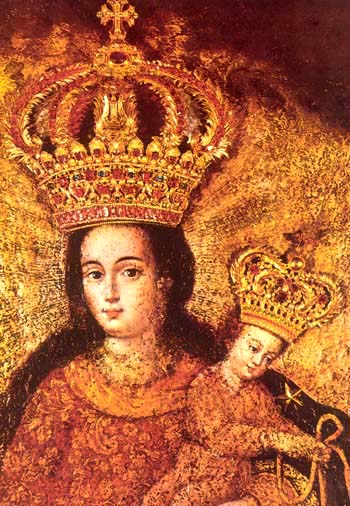Mary, Mother of Our Lord Jesus Christ, has merited numerous titles down through the centuries, many very familiar. Sometimes, though, a new title comes our way – a hidden gem revealing to the faithful another jewel in the crown of devotion to Our Lady.
One such little known title is that of Our Lady of Las Lajas, or Our Lady of the Rocks. This title has its roots in a remote area of southwestern Colombia, South America. It was there that Our Lady made – and continues to make – her presence known in a quite unusual way.
Members of the Franciscan and Dominican Orders had been working zealously in South America, evangelizing native peoples, teaching the truths and traditions of our faith, including devotion to the Mother of God and dedication to her rosary.
The story of this Colombian apparition of Our Lady is summarized by Father Donald Calloway, MIC, in his book, Champions of the Rosary: The History and Heroes of a Spiritual Weapon. Delving into the circumstances surrounding the apparition, we discover numerous miracles.
The year was 1754. In the obscure village of Potosi lived a devout native woman named Maria Mueses de Quiñones. Maria’s little girl Rosa had been deaf and mute from birth. As in other apparitions of Our Lady, this child became a key player in the remarkable events which unfolded.
Maria often walked the six miles to the neighboring village of Ipiales. On one such occasion, Maria, carrying Rosa on her back in the native way, took shelter in a rocky cave or grotto on their way home. Suddenly, Rosa called out to her mother to see the beautiful lady who was calling her! Amazed though she was at her daughter’s newfound ability to hear and to speak, Maria herself saw and heard nothing.
One day shortly afterward, Rosa disappeared from their village. Greatly troubled, Maria returned to the rocky cave, hoping to find Rosa there, and indeed, she did. However, her eyes beheld the most astounding sight: Rosa was at play with the Child Jesus, His beautiful Mother watching over them. Maria and Rosa kept this secret to themselves but returned often to the grotto to pray to Our Lady.
Sadly, a short time later, Rosa became ill and died. Her grief-stricken mother carried the small lifeless body back to the grotto, praying all the while for an even greater miracle for her child. One mother to another, she begged for Our Lady’s intercession. Amazingly, Rosa began to draw breath once again.
Word of this miraculous event spread quickly, and many local people and clergy assembled at the site.
As Father Calloway writes: “While they were there, someone noticed a beautiful image of Our Lady on the rocks. Neither Maria nor Rosa had seen the image there before. No one knew who had painted it or where it had come from. In the beautiful image, Our Lady is holding the Child Jesus and handing St. Dominic a rosary; the Child Jesus is extending a friar’s cord to St. Francis of Assisi.” It seems that Mary’s two devoted sons, whose followers had worked so diligently to bring the local natives to love for her, were being acknowledged by heavenly design.
Father Calloway continues: “After an investigation, civil authorities and scientists determined that the scene was not a painting at all. The image is miraculously part of the rock itself. Geologists have since bored core samples from several places in the rock and discovered that there is no paint, dye, or pigment on the surface of the rock. The colors of the mysterious image are the colors of the rock itself and extend several feet deep inside the rock! The only man-made aspects of the miraculous image are the crowns above the heads of Jesus and Mary that were later added by local devotees.”
Yet another miracle connected to the image concerned a Franciscan named Juan de Santa Gertrudis. Despite total blindness, the friar traveled tirelessly on foot collecting donations for construction of a shrine at the site of the apparition. After a number of years, his task complete, his sight was restored; he credited Our Lady for this miracle.
Several renovations later, the current neo-Gothic church structure is stunning, perched on a bridge 130 feet high, atop the cliffs of the Guaitara River below. Father Calloway writes: “For more than two centuries, the location has been a place of pilgrimage and devotion. In 1951, the Church authorized devotion to Our Lady under the title of ‘Our Lady of Las Lajas,’ and the church built around the image has been declared a minor basilica” by Pope Pius XII in 1954.
Dominican and Franciscan evangelizing efforts bore plentiful fruit as memorialized in the time-honored Marian image, located behind the church’s main altar under a marble archway. Both great saints are portrayed on the image, and the basilica remains in the custody of Franciscan Sisters of Mary Immaculate.
Miracles abound, both in the story of this apparition and its enduring power, attested to by many personal testimonials lining the approach to the basilica.
The Feast of Our Lady of Las Lajas is celebrated each year on September 16th. Numerous pilgrims gather to honor her in the basilica where her miraculous image lives on.
© All Rights Reserved, Living His Life Abundantly®/Women of Grace® http://www.womenofgrace.com










